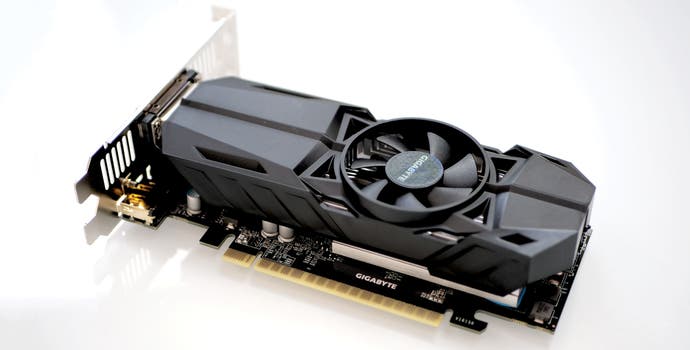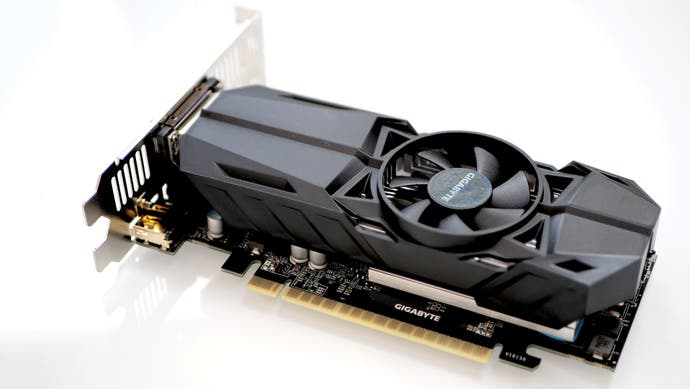Nvidia GeForce GTX 1050 3GB benchmarks: a better budget GPU
Closer in performance to the GTX 1050 2GB than the GTX 1050 Ti.
The GeForce GTX 1050 3GB is a replacement for the older GTX 1050 2GB model which packs in extra VRAM to ensure better performance in modern, texture-heavy games like Battlefield 1 and The Division. Temptingly, its RRP is the same as the 2GB model it replaces - but market forces ensure that you'll often pay a premium for this upgraded model.
Interestingly though, the card isn't a carbon copy of the original GTX 1050 with an extra gigabyte of RAM soldered on somewhere, as you'd expect to perform at least as well as the old card in all titles. Instead, the 2GB model actually outperforms the newer 3GB version in some games, especially older releases. That's because the GTX 1050 3GB is cobbled together with parts from the cheaper GTX 1050 2GB and the more expensive GTX 1050 Ti, and also includes limitations found on neither of its antecedents.
Specifically, the new 3GB card has better compute power in addition to its extra gigabyte of memory, but it actually has lower memory bandwidth than the card that it replaces. That means that the 3GB card will generally perform better in games that keep a lot of textures in memory, but the trend reverses for games that swap textures in and out of memory frequently. On balance though, we expect the GTX 1050 3GB to outperform its 2GB predecessor in the majority of titles, while remaining firmly behind the fully-enabled GTX 1050 Ti.
Which GPUs are worth buying? We've made our picks for the best graphics cards available, updated with the latest graphics cards as they're released. As well as an overall performance champ, we name the best value graphics card and best cheap graphics card to guide your next upgrade.
To give you a better idea of what all this means in specific games, we'll show you how the GTX 1050 3GB compares to the Nvidia GeForce GTX 1050 2GB and GTX 1050 Ti. We'll also consider AMD's budget RX 560 card, which is confusingly offered in two flavours with 14 or 16 compute units (and many more variations besides). In order to give a representative result, we'll include both 14CU and 16CU models of the RX 560 in our tests, both with 4GB of RAM, PCI-e power and equalised clock speeds. Together with Nvidia's best low-end cards, that should give you a good idea of the impression that the GTX 1050 3GB has made in the budget GPU space.

| GPU cores | Boost clock | TFLOPS | Memory | Memory Bandwidth | |
|---|---|---|---|---|---|
| GTX 1050 2GB | 640 | 1455MHz | 1.8 | 2GB GDDR5 | 112GB/s |
| GTX 1050 3GB | 768 | 1518MHz | 2.3 | 3GB GDDR5 | 84GB/s |
| GTX 1050 Ti | 768 | 1392MHz | 2.1 | 4GB GDDR5 | 112GB/s |
| RX 560 (14 CUs) | 896 | 1275MHz | 2.6 | 2GB/4GB | 112GB/s |
| RX 560 (16 CUs) | 1024 | 1275MHz | 2.6 | 2GB/4GB | 112GB/s |
Our benchmarks show how these five cards perform in nine challenging games. On mobile, you'll see a table showing minimum and average performance for each game, but on desktop you'll get a lot more information. That includes a bar chart that shows average performance throughout the run, where you can mouse-over different results for more details or click to change from absolute to percentage-based figures. Even more interesting are our live benchmark runs, which show you how each card performs in sync with a YouTube video of the scene in question. You can even add or remove cards from the comparison, skip around in the video or play it back at double speed, and it remains nicely synchronised so you can see frame-rate and frame-time at any moment. Ah, technology!
Assassin's Creed Unity
We begin our benchmarks with the 2014 Assassin's Creed release, the French Revolution-era Unity. This title keeps a lot of textures in video memory, making it a perfect test for the roomier 3GB GTX 1050 model. As anticipated, the 3GB model out-performs its 2GB counterpart by seven per cent despite its reduced memory bandwidth, showing the impact of that extra gig of VRAM and its greater CUDA core count. However, the 3GB model in turn remains eight per cent behind the GTX 1050 Ti. By comparison, the AMD RX 560 cards do poorly in this test, both recording scores under 30fps.
AC Unity: 1080p, Ultra High, FXAA
Ashes of the Singularity
Next up we have the DirectX 12 strategy game Ashes of the Singularity. This 2016 release includes a challenging benchmark with plenty of lighting effects, bringing the GTX 1050 3GB to just under 29fps at 1080p using the Extreme preset. That's ahead of the GTX 1050 2GB by 16 per cent, but a solid 15 per cent behind the GTX 1050 Ti. Meanwhile, even the faster 16CU version of the RX 560 is six per cent behind the new 3GB Nvidia card.
Ashes of the Singularity DX12: 1080p, Extreme, No AA
Battlefield 1
Battlefield 1 was the first game that really posed a massive challenge for the 2GB version of the GTX 1050, recording a result of just 12fps in the singleplayer benchmark. The 3GB goes a long way to solving this problem, with a much more playable result of 48fps. That's still behind both RX 560 models and the GTX 1050 Ti, but at least this time it's in the same ballpark! There are a few frame-rate spikes here and there, but don't pay them too much heed - they're the result of randomised nearby explosions.
Battlefield 1: 1080p, Ultra, TAA
Crysis 3
While the 3GB version of the GTX 1050 is normally faster than its 2GB counterpart, 2013 title Crysis shows a different story. Here, the lower memory bandwidth of the 3GB model means that the card actually shows worse performance than its predecessor. It's not by much - 42fps for the 3GB model and 43fps for the 3GB alternative - but it shows that the 3GB isn't guaranteed to consistently perform better. However, both cards do at least score a higher result than the RX 560, with the GTX 1050 3GB recording a frame-rate 13 to 16 per cent higher than the AMD hardware we tested.
Crysis 3: 1080p, Very High, SMAA T2X
The Division
The Division (2016) is another title we test in DirectX 12, and another game in which the GTX 1050 2GB showed very poor performance due to its limited VRAM, with issues streaming textures and geometry in the benchmark. Thankfully, the 3GB model largely fixes these problems thanks to its extra gigabyte of memory and greater compute power. The 3GB card outperformed its 2GB brother by a hearty 27 per cent, allowing the card to hit a playable 31fps. This also catapulted the new GTX 1050 ahead of the RX 560 by a small margin.
The Division DX12: 1080p, Ultra, SMAA
Far Cry Primal
Far Cry Primal, released in 2016, is another benchmark that shows the potential downside to picking the 3GB GTX 1050 over the 2GB model. The reduced memory bandwidth results in a noticeably worse frame-rate, with the 3GB card achieving 37fps compared to 39fps of the 2GB card - a difference of around seven per cent. However, even the 3GB card is comfortably ahead of the RX 560 by about 15 per cent. It's worth noting that we are running the high texture pack here, so you could well see better performance without it enabled.
Far Cry Primal: 1080p, Ultra, SMAA
Ghost Recon Wildlands
Ghost Recon Wildlands, released in 2017, is the most challenging title in our current benchmark suite thanks to its punishing Very High preset. None of the five budget cards we've tested is able to crack 40fps even at 1080p, with the GTX 1050 Ti coming the closest at 39.6fps. The GTX 1050 3GB gets the second place slot, at 35.5fps, just a frame ahead of the GTX 1050 2GB. Meanwhile, the RX 560 cards manage to just limp over the 30fps playability standard. We recommend reducing graphical fidelity or making use of your monitor's FreeSync or G-Sync functionality to ensure a playable experience.
Ghost Recon Wildlands: 1080p, Very High, TAA
Rise of the Tomb Raider
The GTX 1050 2GB showed significant stuttering problems in our next benchmark, 2016 release Rise of the Tomb Raider. These issues have been largely resolved with the 3GB version of the card, indicated by the nearly identical lowest one per cent and lowest five per cent figures. The GTX 1050 3GB also shows a healthy 10 per cent frame rate boost over the 2GB card (and the RX 560 models), although it sits behind the GTX 1050 Ti by a similar amount.
Rise of the Tomb Raider: 1080p, Very High, SMAA
The Witcher 3
We conclude our line of straight-up game benchmarks with a multiple GOTY award winner for 2015: The Witcher 3. The ultra preset remains challenging even with the notoriously expensive Hairworks setting disabled, with the GTX 1050 3GB sitting alongside its 2GB brother at 36fps. Here, it looks like the extra compute power and extra gigabyte of RAM have been more-or-less cancelled out by the lower memory bandwidth. There's still an 11 per cent gap to the top-performing budget card, the GTX 1050 Ti. Meanwhile, the RX 560 cards are a stuttery mess, sitting five and nine per cent behind the GTX 1050 3GB.
The Witcher 3: 1080p, Ultra, POST-AA, No Hairworks
Cross-generational comparison
In this special comparison between generations, we'll look at performance in Assassin's Creed Unity see how the GTX 1050 3GB compares to its predecessors. We chose Assassin's Creed Unity this test for a couple of reasons. First, your graphics card can face serious performance challenges from games like Assassin's Creed Unity that keep a lot of textures in memory at once. Secondly, the ultra high preset that we're using here remains an intense challenge for modern GPUs, even when using cheap FXAA over more expensive anti-aliasing options. You can use the Kepler, Maxwell and Pascal buttons to see just how the Nvidia cards of the same generation compare to one another, or leave everything in to see the generational leap in action.
Assassin's Creed Unity: 1080p, Ultra High, FXAA
Assassin's Creed Unity: 1080p, Ultra High, FXAA
Generational comparison
Finally, we'll see how the GTX 1050 3GB compares to the full Nvidia 10-series lineup. As you can see, it slots neatly between the previous GTX 1050 2GB and GTX 1050 Ti cards.
Assassin's Creed Unity: 1080p, Ultra High, FXAA
Now that you've seen the benchmarks for one card, why not check out see which PC hardware we recommend to our friends and family? Here are the DF picks for the overall best graphics cards and for the best gaming monitors on the market.

